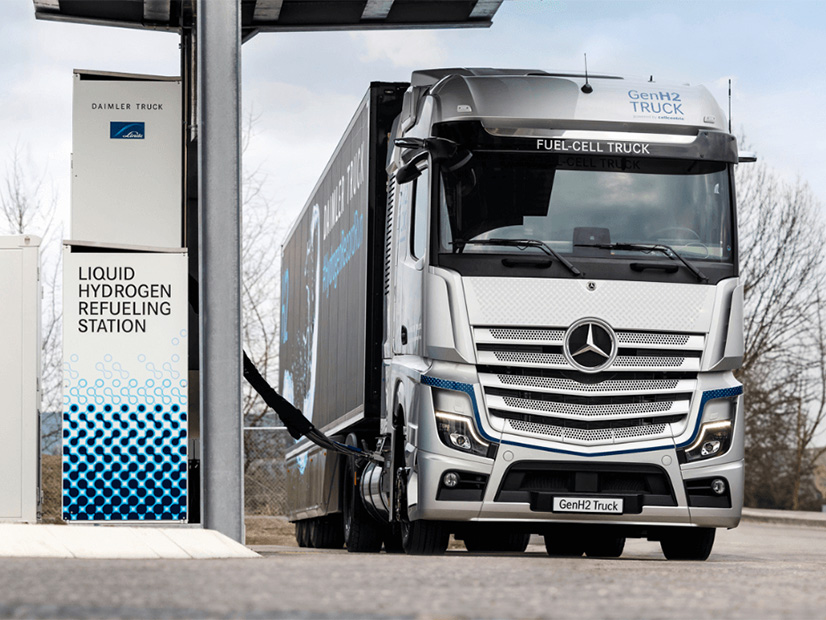
The U.S. Department of Energy wants to reduce the cost of producing clean hydrogen and hydrogen fuel cells with $750 million in funding for 52 projects across 24 states, all aimed at advancing electrolysis technologies and manufacturing and recycling capabilities for clean hydrogen, according to a March 13 announcement.
The goal for the projects receiving the awards from the Infrastructure Investment and Jobs Act (IIJA) is to ramp up manufacturing of electrolyzers to produce up to 1.3 million tons of clean hydrogen yearly and boost the production of fuel cells, which run on the clean hydrogen, by 14 GW yearly.
The increased production of fuel cells alone could power 15% of the medium- and heavy-duty trucks sold in the U.S. each year, according to the announcement.
Electrolyzers produce hydrogen by splitting water molecules into their components of hydrogen and water. For hydrogen so produced to be clean, or green, as it is commonly called, the electrolyzers have to be powered by zero-emissions renewable or nuclear energy.
Medium- and heavy-duty trucks powered by hydrogen fuel cells are being rolled out as an alternative to electric trucks due to their comparative ease of fueling and potentially longer range. For example, the Nikola Corp. has a battery-electric heavy-duty vehicle with a range of 330 miles and a charging time of 90 minutes.
The company’s fuel-cell model offers 500 miles of range and takes 20 minutes to refuel, according to Nikola’s website.
The awards range from a low of $2.4 million for Georgia Tech Research Corp. to develop materials that will lower costs and boost efficiency of electrolyzers, to $50 million for Nel Hydrogen US, which is working toward fully automating electrolyzer manufacturing that, in turn, could improve electrolyzer design.
As quoted in the announcement, Energy Secretary Jennifer Granholm said the new funding will propel “an American-led clean hydrogen economy that is delivering good paying, high quality jobs and accelerating a manufacturing renaissance in communities across America.”
The IIJA allocates $1.5 billion for clean hydrogen and fuel cells, so this announcement represents half of that funding, with $500 million going to electrolyzers and $250 million to fuel cells.
DOE sought funding proposals across six highly technical categories, such as “low-cost, high-throughput electrolyzer manufacturing” (eight projects, $316 million) in which selected projects “will conduct [research, development and demonstration] to enable greater economies of scale through manufacturing innovations.”
The other categories are:
-
- Electrolyzer component and supply chain development (10 projects, $81 million) to support U.S. manufacturing and development needs for core electrolyzer components.
- Advanced technology and component development (18 projects, $72 million) to demonstrate new materials, components and designs for electrolyzers that can “enable cost reductions and mitigate supply chain risks.”
- Advanced manufacturing of fuel cell assemblies and stacks (five projects, $150 million) to support “RD&D that will enable diverse fuel cell manufacturers to flexibly address their greatest scale-up challenges and achieve economies of scale.”
- Fuel cell supply chain development (10 projects, $82 million) to “address critical deficiencies in the domestic supply chain for fuel cell materials and components.”
- Recovery and recycling consortium (one project, $50 million) to establish a consortium of industry, academia and national labs to develop new approaches to recovering and recycling of clean hydrogen materials and components. The consortium is being led by the American Institute of Chemical Engineers, with 15 other members.
A map of the projects chosen to begin contract negotiations with DOE shows a heavy concentration of projects in New York and New England, but North Dakota, Kansas and Oklahoma each scored one project.
Full-court Press
The Biden administration has bet big on clean hydrogen, which “is set to play a vital role in reducing emissions from our most energy-intensive and polluting sectors … such as heavy-duty transportation and industrial and chemical processes like steelmaking and fertilizer production,” according to the DOE announcement.
Clean hydrogen, produced with excess wind, solar or nuclear and stored or put to other uses, is also being promoted as a potential long-duration storage technology.
However, figures in a recent DOE report show that about 95% of the hydrogen produced in the U.S. today uses natural gas as a feedstock. The cost to produce clean hydrogen via electrolysis remains high ― between $5 and $6/kg versus $1 to just over $2/kg for hydrogen produced from natural gas or other fossil fuels.
The latest funding announcement is part of the administration’s full-court press on clean hydrogen, which is widely seen as an emerging technology offering the U.S. an opportunity to show off its innovation chops and lead the global market. The IIJA also provided $7 billion for seven regional hydrogen hubs, announced in October, although two of the hubs plan to use natural gas with carbon capture and a third will use a mix of natural gas, nuclear and renewable energy. (See DOE Designates Seven Regional Hydrogen Hubs.)
Another $1 billion from the IIJA will be used to build up market demand for clean hydrogen, while the Inflation Reduction Act provides a generous tax credit of up to $3/kg for clean hydrogen. (See DOE to Invest $1 Billion to Build Demand for Clean Hydrogen.)
Environmental groups continue to express skepticism about hydrogen. After the hydrogen hubs’ announcement, some advocates called for a refocus on renewables like wind and solar, while others said using natural gas with carbon capture should be called “fossil hydrogen with carbon capture.” (See Hydrogen Hub Announcement Draws Praise and Scorn.)
The 52 projects announced March 13 target some of the underlying manufacturing challenges in the clean hydrogen supply chain. For example, common electrolyzer components, called proton exchange membranes (PEMs), use both platinum and iridium, a byproduct of platinum mined mostly in southern Africa.
The Mott Corp. in Farmington, Conn., is up for a $10 million award to develop nonplatinum group metals for electrolyzers.


